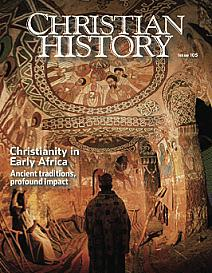VENICE RETURNED MARK'S BONES TO THE EGYPTIAN CHURCH
IN 1959 the Coptic Church elected its 116th primate. The Copts’ way of selecting a pope is to nominate several men for the office. Church leaders then decide on the three or four who seem most qualified. Their names are then concealed in some manner and a young deacon, entrusted to the guidance of the Spirit, selects one at random. In one recent election, names were placed in a crystal bowl and one was drawn by a blindfolded boy.
In 1959, the names were laid on an altar in sealed envelopes. Father Mina El-Baramousy was chosen. He took the name Kyrillos (Cyril) VI and became pope of Alexandria and successor of Saint Mark the Evangelist.
Since earliest times, Egyptian Christians have insisted their church was established by Mark, author of the Gospel that bears his name. Mark died a martyr and was buried in Alexandria. Throughout the early centuries of the church, Christians have made pilgrimages to the site. In 310 a church was built over Mark’s remains. In 644, Muslim conquerors burned the church, but later in that century their rulers allowed the Coptic patriarchs to rebuild it.
Mark’s bones did not stay there, however. In 828 his relics were endangered when a Muslim governor threatened to tear down Christian churches to repurpose the materials to build more mosques. Venetian traders convinced the caretakers of Mark’s relics to transfer the remains to them for safekeeping in Italy. The Doge of Venice received the relics with pomp and they became a magnet for pilgrims.
Curiously, none of the subsequent popes of Alexandria seems to have pressed to have the relics returned—until Kyrillos VI. He asked Vatican representatives in Cairo to return the relics. Pope Paul VI urged the Venetians to part with the remains. They refused. After all, Mark had now been associated with their city for over eleven hundred years and was its patron saint.
Finally, after Kyrillos persisted in his pleas, the Venetians agreed to return a portion of the remains. On this day, 24 June 1968, the remains were welcomed back to Egypt accompanied by a committee of seventy-five bishops, priests, deacons, monks, and laymen whom Kyrillos had sent to get them. Kyrillos himself went up the steps of the airplane and brought the remains down. Two days later they were placed in a shrine in a newly-built cathedral of St. Mark in Cairo. Egypt’s President Nasser, Ethiopia’s Emperor Haile Selassie, and delegates from other churches attended the ceremony.
Kyrillos died in 1971. He was soon declared a saint because of his devout life, his miracles—and because he had recovered Mark’s bones for Egypt.
—Dan Graves
----- ----- -----
For more about the church in Africa, consult Christian History #105, Christianity in Early Africa






